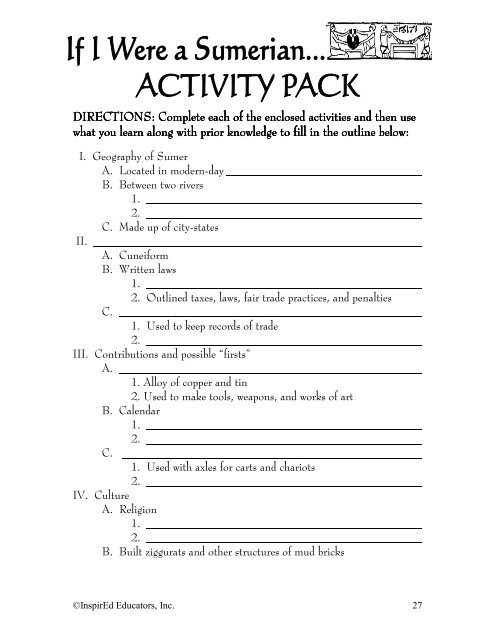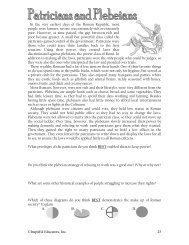You also want an ePaper? Increase the reach of your titles
YUMPU automatically turns print PDFs into web optimized ePapers that Google loves.
DIRECTIONS: DIRECTIONS: Complete each of the enclosed activiti activities activiti<br />
es es and and then then use<br />
use<br />
what what you you learn learn along along with with prior prior knowledge knowledge to to fill fill in in the outline below:<br />
I. Geography of Sumer<br />
A. Located in modern-day<br />
B. Between two rivers<br />
1.<br />
2.<br />
C. Made up of city-states<br />
II.<br />
A. Cuneiform<br />
B. Written laws<br />
1.<br />
2. Outlined taxes, laws, fair trade practices, and penalties<br />
C.<br />
1. Used to keep records of trade<br />
2.<br />
III. Contributions and possible “firsts”<br />
A.<br />
1. Alloy of copper and tin<br />
2. Used to make tools, weapons, and works of art<br />
B. Calendar<br />
1.<br />
2.<br />
C.<br />
1. Used with axles for carts and chariots<br />
2.<br />
IV. Culture<br />
A. Religion<br />
1.<br />
2.<br />
B. Built ziggurats and other structures of mud bricks<br />
©InspirEd Educators, Inc. 27
Living Living by by the the Laws Laws of of of the the Land<br />
Land<br />
The Ur-Nammu law code was written by<br />
the Ancient <strong>Sumerian</strong>s around 2095 BC<br />
according to precedents set by their first<br />
king, Gilgamesh. This cylinder shown at<br />
right is the first copy found that had the<br />
whole text of the code which could be the<br />
world’s oldest written laws. Three hundred<br />
years later King Hammurabi of Babylon<br />
devised laws, long thought to be the oldest,<br />
based on the idea of “an eye for an eye.”<br />
Though many would think the earlier laws<br />
might have been harsher, the opposite was<br />
actually true. The Ur-Nammu code said, “<strong>If</strong><br />
a man knocks out the eye of another man,<br />
he shall weigh out ½ a mina of silver”.<br />
The Ur-Nammu code listed tax codes,<br />
ceremonial laws, courtroom procedures,<br />
rules for fair trading practices, and penalties<br />
for breaking laws. Under this code, slaves<br />
were treated well and had legal rights to<br />
business dealings. Women, though not equal<br />
to men under the law, did have many rights.<br />
Contracts were made by having a scribe<br />
stamp a legal form onto a clay tablet and put<br />
a seal on it. The scribe would fill in details<br />
such as the names of the parties or the<br />
properties involved in the dealings.<br />
BRAINSTORM BRAINSTORM at least THREE laws you think might have been important to<br />
keeping the peace in Ancient Sumer.<br />
28 ©InspirEd Educators, Inc.
Keeping Keeping Time<br />
The <strong>Sumerian</strong>s developed what may be the world’s most ancient calendar.<br />
Theirs was a lunar calendar consisting of twelve months of 29 or 30 days<br />
which measured years in terms of a king’s reign. For example an event might<br />
have been described as having occurred “in the fourth month of the third<br />
year of the reign of Lugal.” There were no weeks in the <strong>Sumerian</strong> calendar<br />
and days began at sunset and lasted for two periods of double six or twelve<br />
hours each.<br />
<strong>Sumerian</strong>s were quite interested in the heavens. They identified and<br />
named the brightest stars, outlined many of the constellations, and kept<br />
track of the movements of the five planets that are visible with the naked eye:<br />
Mercury, Venus, Mars, Jupiter, and Saturn, as well as the sun and moon.<br />
They knew by the positions of these heavenly bodies when seasonal rains<br />
would come, when floods were due, when fields should be planted, and so<br />
forth.<br />
PROBLEM PROBLEM & SOLUTION<br />
SOLUTION:<br />
SOLUTION<br />
The <strong>Sumerian</strong>’s lunar calendar recorded a year that was 355 days long based<br />
on the phases of the moon. The solar calendar used by most countries today<br />
is 365 ¼ days long, 365 with an extra day added every fourth year.<br />
1. How might this difference have caused problems for the <strong>Sumerian</strong>s?<br />
2. How could the <strong>Sumerian</strong>s have corrected this difference?<br />
©InspirEd Educators, Inc. 29
10<br />
6<br />
Counting Counting Counting Sheaves<br />
Numbers in Sumer were probably first used to keep records of trade.<br />
Originally, different trade goods were shown by different symbols repeated to<br />
show quantity. For example three sheaves of grain were illustrated by three<br />
“grain marks.” Though there had to be as many different symbols as there<br />
were products, this system worked well enough for small quantities. As trade<br />
grew, though, there was a need for a simpler counting system.<br />
Gradually the <strong>Sumerian</strong>s devised a better means of recording trades. They<br />
used the same symbol to represent “three” whether it was three bundles of<br />
grain, three chickens, or three jars of oil, followed by a symbol for the<br />
product. While their system was still somewhat difficult to use, it was far<br />
better than their earlier method and allowed for writing much larger<br />
numbers.<br />
1 1 = = 1<br />
1<br />
Complete Complete the the chart:<br />
chart:<br />
= 1<br />
= 1<br />
10 = = 1<br />
= 10<br />
What is the value of ? _______<br />
What is the value of ? _______<br />
What is the value of ? _______<br />
= 60<br />
= = _______<br />
6 = 1 = = ________<br />
_<br />
______ ______<br />
10 = 1 = _______<br />
CHALLENGE CHALLENGE QUESTION<br />
QUESTION: QUESTION<br />
How do you think <strong>Sumerian</strong>s might have<br />
written 3,610 3,610 sheaves sheaves sheaves of of wheat wheat? wheat<br />
30 ©InspirEd Educators, Inc.
Free Free Wheeling<br />
Wheeling<br />
Archaeologists cannot be certain of who invented the wheel. It most likely<br />
developed over time from rolling logs under heavy loads to wheels on axles<br />
under chariots and carts. Still the <strong>Sumerian</strong>s are credited with being the first<br />
civilization to make wide use of the invention. People of Sumer rode in<br />
chariots and carts and they also adapted the wheel for use in making pottery.<br />
<strong>Sumerian</strong> carts, like the one shown at left, had two<br />
wheels fixed on an axle and were pulled by oxen or<br />
other animals. The idea for such a vehicle is believed<br />
to have come about as an offshoot of the <strong>Sumerian</strong>s’<br />
use of animals to pull plows for farming.<br />
The pottery wheels used in Sumer were simple,<br />
rough, circular tables from one to three feet across.<br />
They were supported a few inches from the ground,<br />
pivoting on a kind of small axle in the center and<br />
spun by hand. The pottery wheel allowed the potter<br />
to create fine, balanced bowls, plates, and jugs in less time than hand<br />
building and with far less effort.<br />
DIRECTIONS: DIRECTIONS: Write a paragraph explaining how the <strong>Sumerian</strong>s may have<br />
have<br />
developed developed the the use the whee wheel. whee<br />
l.<br />
(The drawings above should should be of help.)<br />
©InspirEd Educators, Inc. 31
Pleasing Pleasing the the Gods<br />
The religion of Sumer was polytheistic, meaning people worshipped<br />
many gods. The <strong>Sumerian</strong> gods were thought to be very powerful; able to<br />
control natural events such as life, death, weather, floods, and other<br />
important aspects of life. Each city-state was believed to have belonged to a<br />
different deity, which its people prayed to for protection and good fortune.<br />
The <strong>Sumerian</strong>s believed their gods were much like humans with human<br />
needs for food, drink, and love. They also believed their gods could become<br />
jealous, angry, or happy, and so spent much time trying to please them.<br />
<strong>Sumerian</strong>s gave offerings to the gods and built great temples in their honor.<br />
High, stepped structures called ziggurats were<br />
built in city-states throughout Sumer to please their<br />
local deities and other gods. The ziggurats, like most<br />
other <strong>Sumerian</strong> buildings, were constructed of mud<br />
bricks. Temples built atop these great stone<br />
“mountains” allowed humans to climb the many stairways to be in the<br />
presence of the god for whom it was built, though in many cases only priests<br />
were allowed to do so.<br />
DIRECTIONS: DIRECTIONS: CCompare<br />
C ompare and contrast the religion of of Ancient Ancient Sumer Sumer with with<br />
with<br />
another nother religion with which you are familiar.<br />
<strong>Sumerian</strong> <strong>Sumerian</strong> <strong>Sumerian</strong> Rel Religion Rel gion<br />
32 ©InspirEd Educators, Inc.



